#amplus
Text

Boost Your Online Presence with Our Pay-Per-Click Management Services!
Struggling to maximize your digital advertising ROI? Let us handle your Pay-Per-Click (PPC) campaigns and watch your business soar!
Contact Us @ 9392923999
2 notes
·
View notes
Text
Say Hola to Santa Ema at VanWineFest 2023
Say Hola to Santa Ema at @VanWineFest 2023 @WinesOfChile_CA #SauvignonBlanc #Syrah #Cabernet #Amplus #Catalina
Here we have Chile’s Santa Ema winery telling us about their history and the wines they will be pouring at the Vancouver International Wine Festival. Enjoy.
About Santa Ema
With over 60 years of professional experience, Santa Ema are pioneers in the Maipo Valley where they are always searching for the best expressions of terroir, from the mountains to the coast.
Santa Ema’s founding Pavone family…

View On WordPress
#@vanwinefest#Amplus#cabernet sauvignon#chile#Leyda Valley#Maipo Valley#Santa Ema#sauvignon blanc#syrah#Vancouver International Wine Festival
0 notes
Text

Amplus funds and installs a rooftop (or Ground-mount) solar power plant on your premises. Solutions are customised to suit your requirements and include carports & superstructures.
As a customer, you get the multi-fold-benefit:
Zero investment
from customer
No Techno-financial
risk for customer
Guaranteed Savings
for every unit purchased
End-to-End
service delivery
Hassle-free Maintenance
ensuring high performance
Link: https://amplussolar.com/onsitesolar
0 notes
Photo

“Knowledge is power. Information is liberating. Education is the premise of progress in every society, in every family.” —Kofi Annan
School admission at Brigade Public School, Attapur open for 2023-2024
Curriculum: CBSE
Class: Nursery To Class VIII
Contact: 9000 241 261
0 notes
Text
Jakson Green to build 121 Mega Watts Peak solar power plant for Amplus Solar
Jakson Green Will deliver a state-of-the-art solar power plant on a the turnkey EPC basis.
Jakson Green to build 121 Mega Watts Peak solar power plant for Amplus Solar
Amplus Solar has placed a solar EPC order with Jakson Green, the new energy transition platform supported by India’s Jakson Group.
Jakson Green to build 121 Mega Watts Peak solar power plant for Amplus Solar
Jakson Green will…

View On WordPress
0 notes
Text
0 notes
Text

Watch me whip, now watch me nae nae 🕺
The large whip goby (Bryaninops amplus) is a small, elongated fish known for its vibrant colors and slender body. This goby lives in coral reefs of the Indo-Pacific, including Hawaii and excluding the Red Sea. Members of this species are typically found in groups, living exclusively on or in close association with soft coral sea whips in areas exposed to currents. The currents help bring the gobies their food of choice: plankton. Like many other symbiotic gobies, they have special pelvic fins that help them cling on to the surface of their host. Their bodies are semi-transparent, which helps them blend in better with the soft corals they dwell on.
📸: Paul Rosenblum (2022 Get Into Your Sanctuary Photo Contest submission)
33 notes
·
View notes
Text
Small diorama with Cambrian giant Omnidens amplus

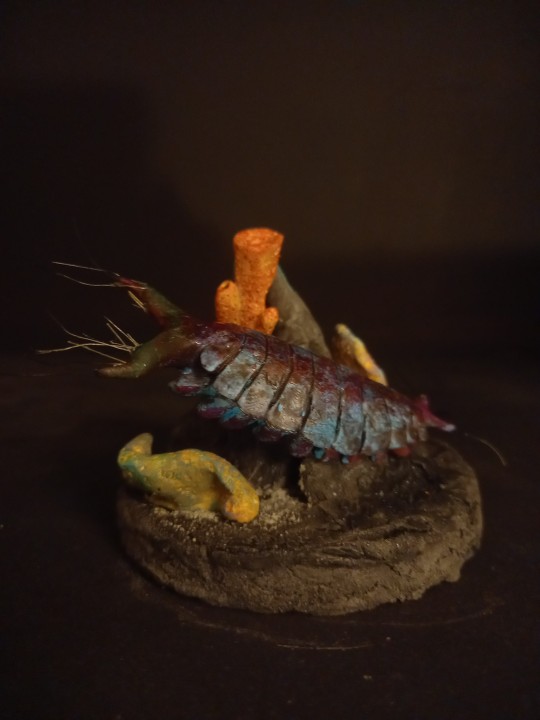


29 notes
·
View notes
Photo

Omnidens amplus
Omnidens amplus is an extinct panarthropod from the Cambrian Maotianshan Shales of China. It could grow up to 1.5 metres (4.9 ft) in body length.
License this stock resource at: https://paleostock.com/resource/omnidens-amplus-stock-photo
Illustration by Prehistorica
#paleoart#sciart#science#nature#paleontology#geology#fossil#fossils#evolution#art#illustration#paleostock
112 notes
·
View notes
Text


Omg, I actually really looked at Lewisohn's email address
But first I Googled to see if I could find another email for Mark Lewisohn besides the “professional enquiries always welcome” one, and Google loves him.
In the “People also ask” tabs:
Question: Who is the expert on the Beatles?
Answer: Mark Lewisohn
Mark Lewisohn is the acknowledged world authority on the Beatles.
[Search for: Who is the expert on The Beatles?]
So I did.
Google search: Who is the expert on The Beatles?
Answer: Mark Lewisohn
Mark Lewisohn is the acknowledged world authority on the Beatles. His books include Tune In (which is the first volume in his historical trilogy The Beatles: All These Years) as well as the bestselling and influential Recording Sessions, The Complete Beatles Chronicle and (as co-author) The Beatles' London.
I had only given a quick glance at the email address on his website, and with the “professional enquiries” note I assumed it was a PR person or publisher, but once it seemed like that was the only one I would find, I noticed the Latin. (Latin was the only subject my mother ever forced me to take.) His actual email address is amplusnarratio @
Narratio is pretty obvious.
Amplus (ampla) is Latin for glorious, distinguished, magnificent, esteemed, honorable, splendid.
We choose our own email addresses, and I am happy to say that Mr. Lewisohn has a healthy opinion of himself.
(I am going to email him about the logbook. I don't expect him to answer—or have an answer—but it seems only fair. And I will admit to being curious.)
I'll keep you updated.
16 notes
·
View notes
Text

Like eCommerce, online marketplaces, and service providers, are you looking for a mobile application that can enhance your business? We can help you out with this!
Contact us today!
Contact Us @ 9392923999
0 notes
Text
Omnidens amplus doodle

#speculative biology#speculative ecology#speculative evolution#traditional art#speculative zoology#traditional sketch#spectember#specposium#paleontology#paleomedia#paleoillustration#paleoart#paleo art#paleontologist#paleostream
16 notes
·
View notes
Text
Prehistoric fauna are a goldmine of g/t potential
Just look at the size difference between various dromaeosaurids, the largest of which are almost as big as rhinos

Or the sauropods which towered over every living thing (except trees), some of which were so massive that their footprints left pools of quicksand
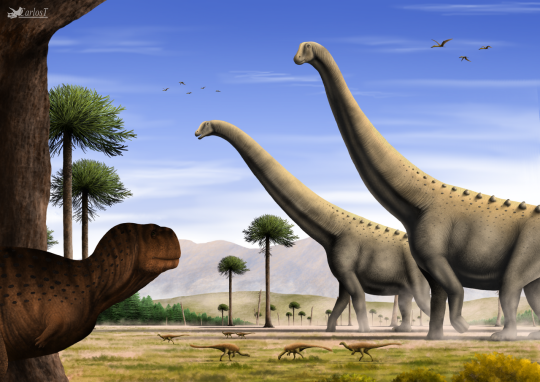
Or the ancient predator Omnidens amplus, which is so big compared to other Cambrian life that paleoartists almost always depict it looking like an eldritch god
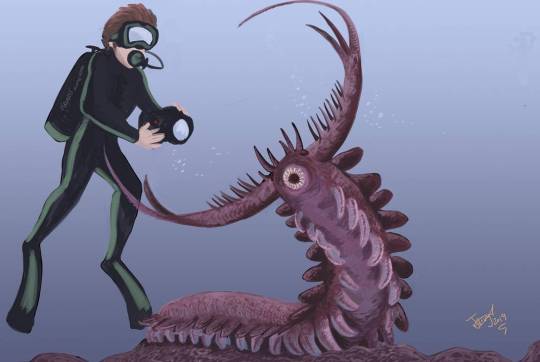
Or the millipede ancestor arthropleura, which I have actually used for such things and was the largest terrestrial arthropod to ever exist
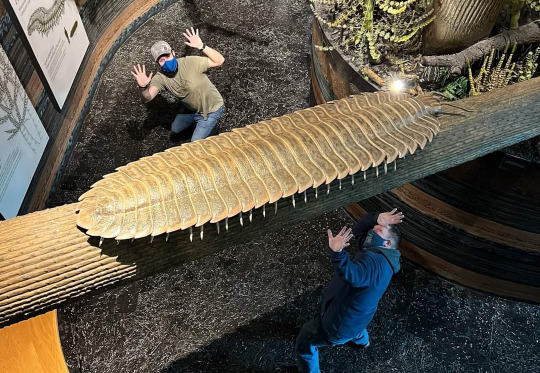
Or the megalodon which was so big that its natural rival is called "The Leviathan"
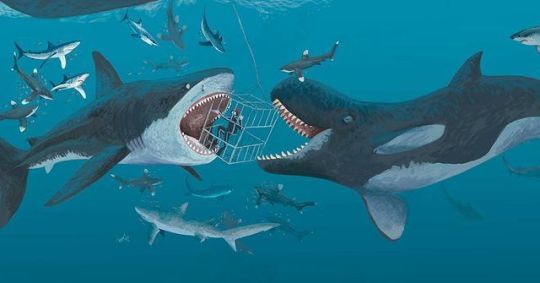
Or hatzegopteryx, a giant stork-like pterosaur that flew across the many islands that once existed in Europe, the dinosaurs on which were rarely bigger than horses as the islands couldn't support huge beasts
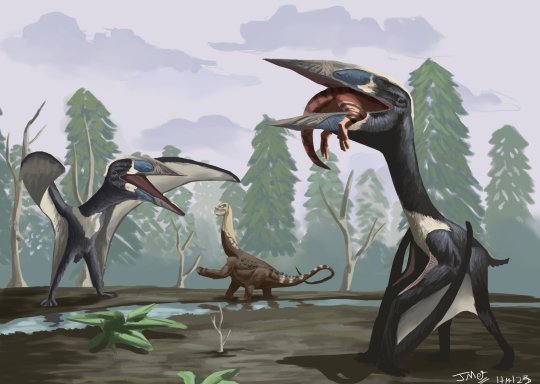
Or whatever the hell this thing is

#g/t#credit for the dromies: FredtheDinosaurman#Credit for the Argentinosaurus: Carlost1205#Credit for the worm thing: HodariNundu#Credit for fatass whale: Hryotrioskjan#Credit for hatzegopteryx: joaothelegend#Credit for megalodon and livyatan: HodariNundu
17 notes
·
View notes
Text
[10 / 21 / XX22 ]
While I was supposed to post this entry last night, I was busy with talking to my family, who I miss dearly. I have no need to apologize. Family is the most important thing after all, correct? Why else should corporations parade the term around in the workplace? How else would we survive, without our loved ones? Could you imagine?. . . Well, there is one remarkable organism that might shudder at sharing a space. I introduce you to one of the most fascinating pseudoflora I've ever had the Fortune to discover: Amplus nutrio, the pellet posy. This sturdy pellet weed is a marvel of biochemistry.
The stem of A. nutrio possesses the unique muscular fiber of other pseudoflora, which swell and shift with hydraulic pressure. This occurs in a series of electrochemical reactions that, like in animal protein, cause the entire "yarn" of protein to twitch. It's not moving these muscles as one does to autonomously breathe, but is thigmotropic to a marvelous degree.
Think of their design as so: While most animals require the steady use of energy and expulsion of heat to power complex systems, and plants expel a large amount of electronic surplus as aerobic chemicals, pseudoflora are very nearly the most selfish organisms alive! They retain massive amounts of free energy while allowing for as little heat waste as possible. This is often considered detrimental to the evolution of life, as such densely packed energy in an intentionally open system can become very dangerous for cellular structures that rely so deeply on chemical processes. However, this subset of organisms rely on their hyperactive charges and heat energy to meet a single goal in rapidly explosive fashion. In pellet posies, this goal is maturation. They are far less ambulatory than other pseudoflora, but make up for it with their efficient feeding tactics. A pellet posy uses its muscular fibers to absorb and transport a great amount of water very quickly, and to quite literally feel around the loose soil they inhabit for organic litter (often left nearby by wandering larvae). Their fleshy inner stems are protected by a leafless outer rind that is heavy in silica and lipid content, providing protection. Because it depends so largely on a sustainable food source, posies often only grow in areas rich with shortlived soil-dwelling species, and function best when they do not have to share with members of their own species. As such, they are quite rare.
My current hypothesis is that this is a mixotrophic species that absorbs nutrients from organic matter, processes it for the composition of starches and cellulose, and promptly pulls the rest of the leftover wet solution into its pistil, where the dainty whites of its petals reflect sunlight (and moonlight) away from the opening of the flower head. This allows the hot metabolic nectar to cool, and overnight, it crystallizes! Within this crunchy morsel of ample nutrients, it hides its seeds. When the posy reaches this mature stage, the base of its stem weakens due to the force of gravity upon its mass, allowing it to become cleanly broken off with enough jostling.
The appetite of nearby animals then proves beneficial as they force the fruitful flower into their reach, and shatter and scatter the pieces of that heavy crystal around! This will bring the damaged posy into dormancy, where its broken stem (unappetizing and full of stored fat) will be recycled by its seeking roots. The next dawn, the posy will begin phoyosynthesizing. Because it only expels waste in its nectar crystal, all of the hyperactive ions taken from light energy speed up the impossibly fast regeneration cycle.
To summarize, this pellet weed is selfish and suicidal, but its ability to franchise itself is matched by only one other species: Pikmin. I believe I'm ready to begin writing my next piece, soon!

-Captain Olimar
#SAD Blog Canon#SAD Art#Answered by Olimar#Captain Olimar#Olimar Pikmin#Pikmin#ask blog#mod note: This is a scientific stretch. He's a little silly and I'm getting creative.#SAD Dad Blog
30 notes
·
View notes
Photo

Visvim Lieutenant P-Coat / Amplus Crew Knit / Biker Cap / Kanawa Moc Mid-Folk / Stetson Slacks #panchoandlefty #visvim #visvimgang #peacoat https://www.instagram.com/p/CkusrMVoH7f/?igshid=NGJjMDIxMWI=
23 notes
·
View notes
Photo
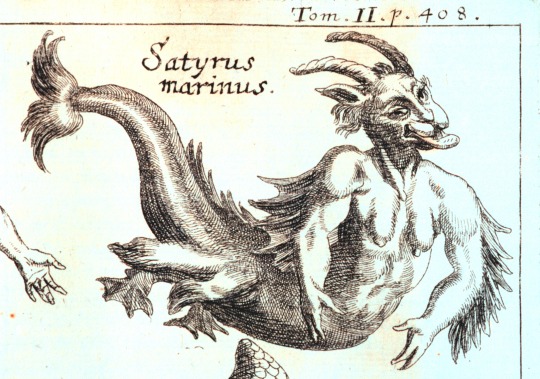
Satyrus marinus, or the marine satyr [17th century Europe]
Supposedly, a strange aquatic creature was spotted on the coast of Sibenik, a city in Illyria, which is a historical region in what is now the western Balkans (Sibenik is now a city in Croatia). The being was slightly humanoid and had two legs, each of which ended in a fish-like tail. From these tails, a wing-like membrane sprouted that ran up all the way to the creature’s arms and was compared with the wings of a bat. Although presumably, they were fins meant for swimming rather than flying. The creature had two arms, each of which ended in a hand with two fingers.
Its head resembled that of a human, but it was adorned with two small horns. The being’s skin resembled that of an eel. It was attempting to drag a boy into the sea, but it was seen by locals before it could accomplish this. The people banded together and the mob beat the creature with clubs and stones before dragging it onto dry land. It is unknown what became of the mysterious creature.
You have probably noticed that the accompanying image only barely matches the description. In fact, I believe it was added as an illustration of a general humanoid sea monster and it might have been a coincidence that it matched the description of the creature from Sibenik, because the monster from the text is never explicitly referred to as “Satyrus marinus”. The image appeared in Schott’s Physica Curiosa, a book that predated Zahn’s work by 30 years. The Satyrus marinus is mentioned here, but only briefly, and no details are given on the creature. Both authors reproduced the image from the 1642 Monstrorum Historia.
I was overjoyed to find that the Monstrorum historia does contain a passage on the marine satyr, after the other authors seemed to have no information on this enigmatic creature at all. I might be making a translation error here, since I’m not exactly fluent in Latin, but if I understand it correctly, Aldrovandus claimed that the term ‘triton’ (which originally referred to a singular character from Greek mythology, but the name was later used to refer to merpeople in general) is used as an all-encompassing term for marine human-like creatures that includes the satyrs.
Aldrovandus wrote that these aquatic satyrs were commonly assumed to be non-existent by scholars and that sightings of these creatures were actually of diving swimmers and fishermen. However, he also highlighted that there are several learned authors who believe that “marine satyrs” do exist in the sea. Supposedly, these creatures lived in the seas surrounding Sri Lanka – which was known as Taprobana by the ancient Greeks and referred to as such by Aldrovandus – where they inhabited the tropical waters. But the marine satyrs – or similar creatures – were supposedly also spotted in the Nile delta in Egypt. A group of men supposedly saw a pair of these beings emerging from the water: one of them was bearded and male, while the other had no facial hair and was assumed to be female. They received the appellation of “Nile monsters”.
There is also a claim that the local people of Dalmatia – which is part of Croatia – used to capture and kill these creatures (or similar creatures) to take their skin, as their eel-like skin was very strong and could be used to fashion shoes that would last over 15 years. There are probably some ethical complications there, but the shoes were of a high quality.
Sources:
Zahn, J., 1696, Specula physico-mathematico-historica notabilium ac mirabilium sciendorum: in qua mundi mirabilis oeconomia, nec non mirificè amplus, et magnificus ejusdem abditè reconditus, nunc autem ad lucem protractus, ac ad varias perfacili method acquirendas scientias in epitomen collectus thesaurus curiosis omnibus cosmosophis inspectandus proponitur.
Schott, G. P., 1662, Physica curiosa, sive mirabilia naturae et artis libris XIII. Which you can read here.
Aldrovandus, U., 1642, Monstrorum historia cum paralipomenis historiae omnium animalium, which you can read here.
(image source: Specula physico-mathematico-historica notabilium ac mirabilium sciendorum, Johann Zahn, 1696. Image taken from Wikipedia, as it’s a much higher quality than the scanned copy of the book which is available to me)
#mythical creatures#miscellaneous#mythology#cryptids#cryptozoology#medieval#well not actually medieval#aquatic#monsters#creatures
61 notes
·
View notes